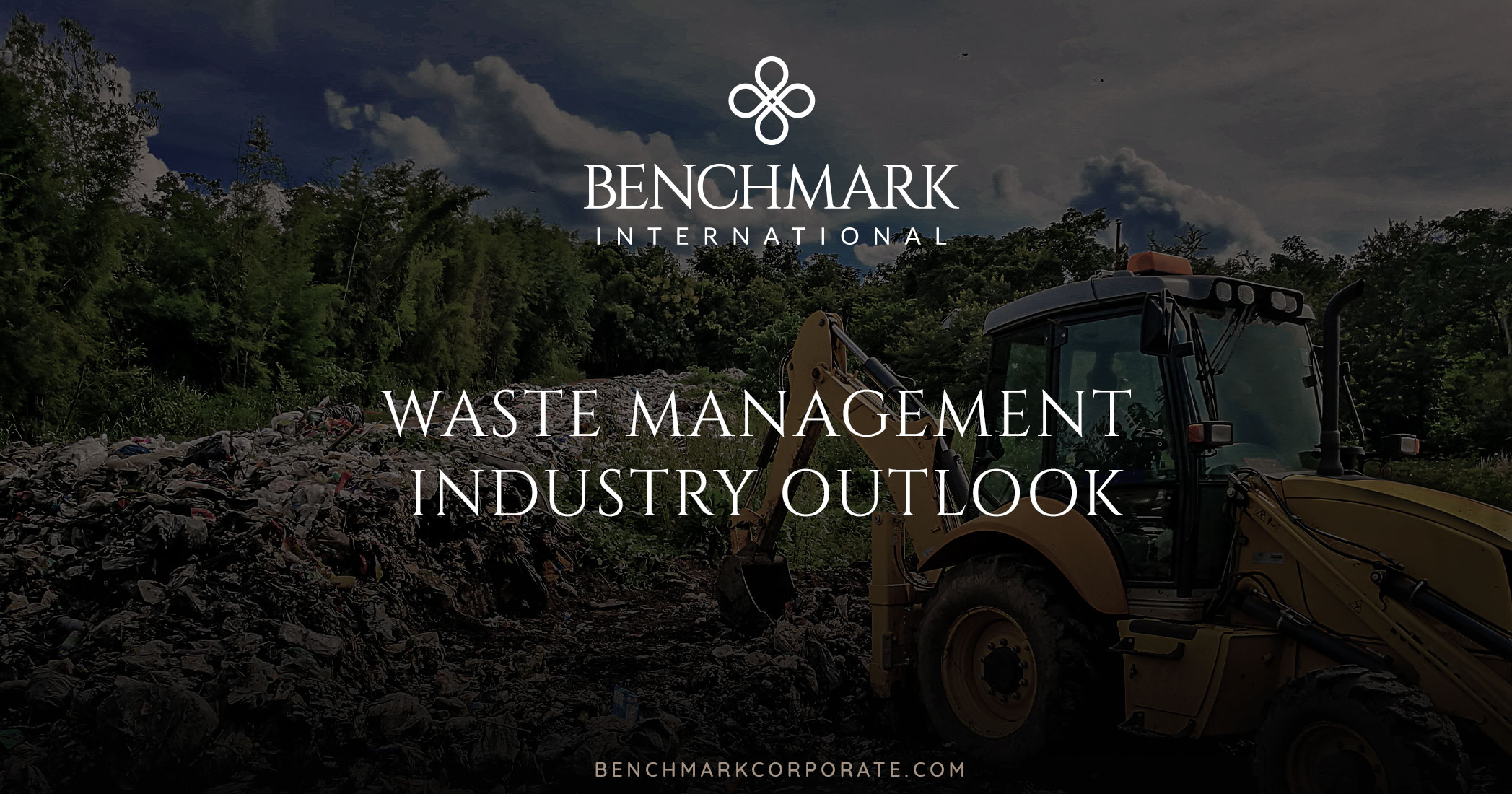By 2027, the e-commerce market forecasts a volume of $6.35 trillion by demonstrating a compound annual growth rate (CAGR) of 11.51%.
READ MORE >>Archives
2023 Global E-commerce Industry Report
Global Waste Management Outlook
The global waste management industry is expected to grow at a compound annual growth rate (CAGR) of 6% leading to 2025, with industry experts anticipating an overall value of $530 billion. An increase in environmental awareness, an increasing population, and a rise in urbanisation are all key to growth in the industry. Furthermore, implementation of stringent government norms towards dumping is anticipated to lead to further growth over the coming years.
Where uncollected waste and dumping are impacting on health directly, this is expected to be another key factor leading to growth in the market. However, a lack of awareness and investment in developing countries is expected to hinder growth inthe industry inthose regions. With that being said, the general consensus is that the positive factors in the industry will exceed any negatives, hence the projected CAGR of 6%. Furthermore, emerging economies in Asia-Pacific, Latin America, Middle East, and Africa are contributing to growth in the industry through the implementation of solid waste management solutions, which will spread awareness in those regions and increase the number of regions developing them in the near future.
Europe is expected to dominate the waste management market share over the coming years, owing to increases in favourable government initiatives, along with high-end technology adoption by management services. However, Asia is the region that is expected to drive the demand for waste management services, due to the presence of densely populated countries such as China and India where an increase in urban penetration is being witnessed. Moreover, as with Europe, government initiatives in the region are expected to increase the demand for waste management services.
Key Industry Factors
- In 1960 the United Nations found that the global urban population was just 34% revealing plenty of potential growth, last year that figure stood at 55%. Furthermore, estimates by the World Health Organization predict the figure to increase by approximately 1.84% every year until 2020, at a rate of about 1.63% per annum from 2020 to 2025, and around 1.44% per annum from 2025 to 2030. Naturally, as the urban population increases, the amount of waste being produced will also increase – in-fact the amount of municipal solid waste (MSW), a crucial by-product of urban lifestyle, is growing at an even higher rate than that of urbanisation.
- The World Bank found that in 2016, the world’s largest cities generated 2 billion tonnes of solid waste, which amounts to a footprint of 0.74 kilograms per person, per day. With rapid global urbanisation, annual waste is expected to increase by 70% from 2016’s figure to 3.4 billion tonnes in 2050.
- Increasing levels of environmental awareness regarding factors such as renewable waste management systems or rising carbon dioxide emissions are expected to lead to further growth opportunities in the industry. Businesses in the industry have been pivotal in ensuring as much MSW as possible is recycled and are conducting programs for non-hazardous industrial waste management to reduce pollution and mitigate environmental hazards. Moreover, untreated waste and dumping affect health directly and indirectly by spreading infectious diseases, thereby boosting the demand for waste management services.
There are plenty of factors that give us reason to be confident about the future of the waste management industry. With no sign of urbanisation slowing down, waste management will continue to be an integral part of the global economy.
Share this:
Where Will Lower-middle Market M&A Be In A Year From Now?
The Current Market
The lower-middle market has remained positive for sellers in 2019, thanks to an abundance of buyers that are giving sellers the leverage to demand favorable terms. Most business sectors are seeing strong profits, and the bullish optimism of large-cap investors has spilled over into lower and middle markets. This has resulted in heightened interest and aggressive valuation and buying from private equity firms.
There are several patterns have carried over into 2019 from a very active year in 2018.
• M&A activity has been especially strong in the healthcare and technology industries.
• Acquisitions remain a popular strategy for companies needing talent to keep up with growth.
• Buy-and-build strategies are proven to be working.
• Emerging markets are being attractively valued, especially in the Asia Pacific region.
• Competition for high-quality targets is intense, particularly for businesses that are owned by the rapidly growing retiring population.
• Small business confidence is strong, resulting in increased investment by owners.
What Lies Ahead
The world faces potential changes in the political landscape as the United States 2020 presidential election nears, Britain is under new leadership through the Brexit transition, and the global economy navigates significant political unknowns in the wake of trade deals and tariffs. However, the United States election takes place near the end of 2020, which could possibly stave off any significant effects on the economy until the year 2021.

While no one can ever be certain what the future holds, we still see the benefits of a strong year midway through 2019, yet the lower-middle market has the potential to become more complicated in 2020. The current bullish market is strong but is expected to lose momentum based on the average amount of time that historical highs have been proven that they can be sustained. Many experts warn of a downturn in the economy next year, predicting that a recession is looming. In contrast, some experts expect M&A activity to remain robust regardless of the economy.
Obviously, uncertainty in the marketplace can impede M&A activity. But a recession does not necessarily mean that selling will be impossible. The variables that drive lower-middle market M&A include:
• Lending capacity: The less money a buyer can borrow, the less money they may want to spend.
• Cost of capital: The cheaper a buyer can borrow, the more money they may want to spend.
• Buyer access to equity capital: Strong profits and surplus cash motivate activity.
• Supply and demand for deals: Aging populations entering retirement and business succession plans, strategic buyers focusing on growth, etc.
In the lower-middle market, buyers and lenders both tend to stay much more disciplined regarding their willingness to lend, cost at which they lend, and returns they target. Buyers will be seeking targets with stability, limited cyclical exposure, a business model with recurring revenue, and a history of performing well through a recession.
Should You Sell Now?
The good news is that there is still time before a possible slump in activity and optimism. If you are looking to sell your business, you may have another 12 to 18 months to benefit from the premiums today’s sellers are getting. Keep in mind; it does not mean that after this time is over, you will not be able to sell. Companies are always looking to grow through acquisitions, and the market is always changing. You do not need to feel completely discouraged by any economic slowdown.
Consider how long you are willing to wait to sell your business if the market were to drop. If you do not plan to sell within around five years or more, you can wait patiently for the next market rebound. But if you are determined to sell in the next couple of years, it may be wise to get serious about your exit strategy while conditions are still favorable. Think about what is right for you, your business, and your family when deciding when to make a move.
Contact Us
Our business acquisition experts at Benchmark International can offer exit planning advice and help you plan a solid transition for your company. We will use all the tools at our disposal to get you the maximum selling price while preserving your vision for the future. We can also help if you are looking to buy a business. Contact us today.
READ MORE >>Share this:
Here are the Reasons Why Private Equity Firms are Investing in SaaS Companies
There has been a steep incline in private equity investors buying SaaS (software as a service) companies over the last five years with PE firms investing in, recapitalising, and outright buying numerous SaaS companies. In fact, private equity accounted for 2.5% of all private equity portfolio acquisitions in 2018.
So, what are the reasons for private equity firms investing so heavily into SaaS companies?
READ MORE >> Benchmark International
Benchmark International  Benchmark International
Benchmark International 




